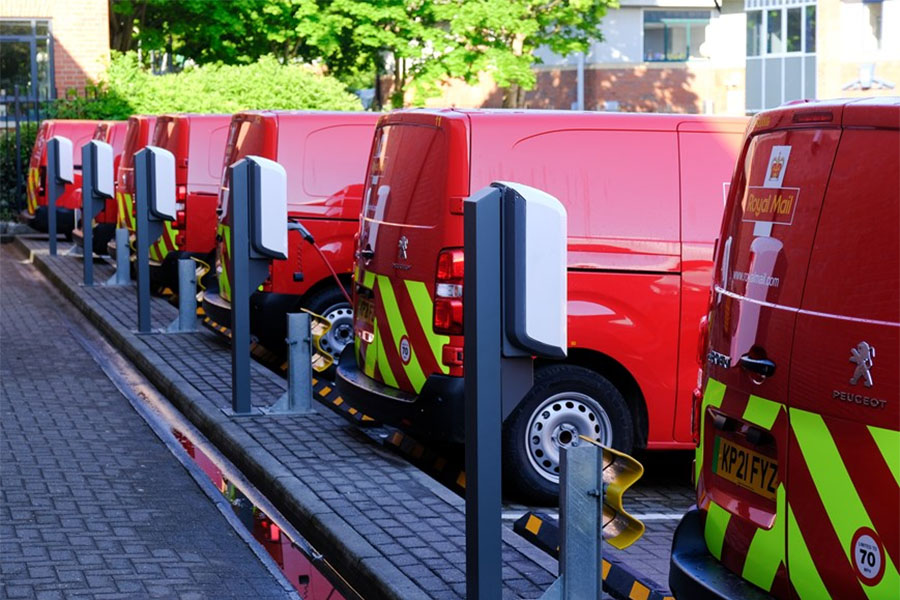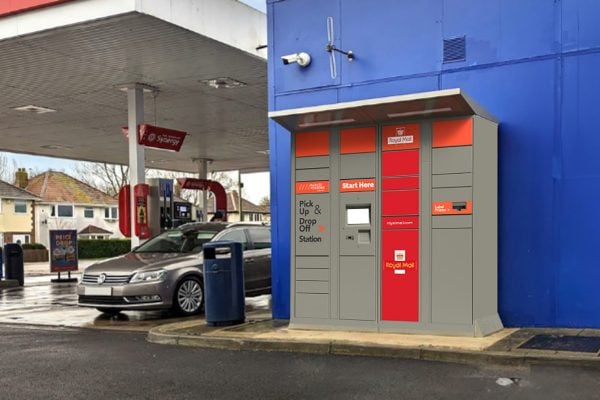Royal Mail electric vehicles are going to increase ten-fold increase as the postal service announces plans to introduce around 3,000 additional, low-emission vans across its UK fleet .
The vehicles, liveried in traditional Royal Mail red, are a new chapter in the Company’s ongoing drive to reduce its operational emissions still further. Naturally these vans need topping up, so Royal Mail will aslo introduce charging points to all the Delivery Offices set to receive the Royal Mail electric vehicles as part of the plans. The roll out of the vans will initially focus on ultra-low emission zones and green cities.
The Royal Mail electric vehicles are specially designed to help postmen and women deliver letters and parcels in a secure and environmentally-friendly way. With load capacities ranging from around 3.7m3 to 6.3m3, the vehicles will operate as part of the Company’s usual delivery routes.
The addition of this latest tranche of Royal Mail electric vehicles brings the total amount of electric vehicles operating within their fleet to around 3,300.
Royal Mail say that electric vehicles are not only the right move for the environment, their people and their communities, but they also increasingly make more economic sense for the Company than diesel vehicles in the long-term.
“Due to our feet on the street delivery model, we are the clear leader in low emissions per parcel in the UK. Electrification of our vehicle fleet will strengthen our advantage. That’s good for our customers, our people & the planet. We look forward to working with vehicle manufacturers and government to increase supply so we can accelerate our transition to electric vehicles in the UK. It matters to our customers, and it matters to us.”
– Simon Thompson, CEO, Royal Mail
“I am sure customers will be delighted to know that that while their local postie’s van may be red on the outside, it’s greener than ever at heart. The UK is leading the world in tackling climate change, and action like this from UK businesses will be crucial as we look to build back greener from the pandemic.”
– Kwasi Kwarteng, Business Secretary
Are electric vehicles really the way forward?
There is no doubt that electric vehicle running around towns and cities produce way less emissions (zero in fact) compared to the old diesel vehicles and they are perfect for delivery companies. But I’m still unconvinced that they actually greener when you take into account the hard metals that have to be mined for the batteries, the fact that if they have a minor knock that damages the battery it’s likely to write off the entire van, and the still largely unknown total lifespan of the vehicle.
Running a fleet where you regularly renew vehicles on a regular basis might make the total lifespan of the vehicle less important for fleet managers, but there are plenty of 10 to 15 year old ex fleet diesel vans that have found a second life but no one really knows how long a battery van will last before it’s mileage is so poor no one wants to run it any more.
Then there is the ultimate disposal – what happens to the batteries when vehicles are dismantled, which in itself will be a more tricky procedure. The days of a grab simply clamping on to the engine and swinging until it releases from the car body which is then crushed and recycled with the engine sent to be melted down are gone. The battery will have to be carefully removed by hand for certain.
What do you think? I’m all in favour of electric from the zero emissions perspective but are we storing up a can of worms for the future. Over the total lifespan of an electric van is it better, the same, or worse than diesel from material mining to eventual scrapping?
Personally I would love to see a choice of more than two models of hydrogen powered vehicles (Toyota Mirai and Hyundai NEXO) and more than the current 11 hydrogen filling stations in the UK. Currently, if I had a hydrogen powered vehicle, it would be a 65 mile round trip to my nearest hydrogen filling station which just isn’t practical, but I’d love a car whose emissions are water and a five minute fill up is good for 300 miles as soon as they become mainstream.
Royal Mail are doing a great job with the tech available today and no one can knock the new fleet of Royal Mail electric vehicles, but we need better, especially when we move from a van trundling around a delivery route to a car that you want to drive from Reading to Manchester and back in a day without having to stop for an hour to charge it up.
Royal Mail’s Ambitious Plans
In May, Royal Mail announced the launch of 29 low emission gas powered trucks, fuelled by Bio-Compressed Natural Gas (Bio-CNG). The 40 tonne Heavy Goods Vehicles (HGVs) are similar in size and look to a conventional Royal Mail truck but are significantly quieter. They also emit roughly 84 per cent less CO2e than a typical diesel-fuelled vehicle of this size.
Also in May, Royal Mail announced the launch of its first ever Delivery Office to feature an all-electric fleet of collection and delivery vehicles. The Bristol East Central Delivery Office, located in the City’s Easton area, has had its 23 diesel delivery and collection vans replaced by fully electric equivalents – comprising the Office’s entire collection and delivery fleet. Six electric charging posts and 12 charging points have also been installed on the site as part of the transformation.
Bristol was selected due to the City’s plans for a Clean Air Zone (CAZ), which will require certain vehicles to pay a daily charge to enter its centre. At present, other Delivery Offices across the UK are being considered for similar fleet makeovers in coming months – particularly those in places with existing CAZs, or that have plans to introduce them.
With the UK’s largest “Feet on the Street” network of over 85,000 postmen and women, Royal Mail already has the lowest reported CO2e emissions per parcel amongst major UK delivery companies. The expansion of alternative fuel vehicles demonstrates the Company’s commitment to reducing emissions associated with its operations, and to delivering a cleaner future.
120 years of Royal Mail motorised vehicles
Some interesting fast facts on Royal Mail’s fleet:
- This year marks over 120 years since Royal Mail first experimented with using motorised vehicles to deliver the mail.
- Prior to the introduction of the General Post Office mail coach service, the mail was chiefly delivered by horse and cart or foot.
- John Palmer of Bath’s mail coach service proposal was approved in 1784, and enabled the rapid expansion of the General Post Office throughout England, Wales, Scotland and Ireland.
- Experiments with motorised transport for carrying mail began in 1897 when discussions started around whether it was best to use steam, electric or ‘oil driven’ motors. Each type of engine was tested and in 1904 a second-hand Wallis & Steevens traction engine was purchased – Royal Mail’s first motorised vehicle.
- The traction engine was a self-propelled steam engine that was primarily used to move heavy loads on roads, plough ground or to provide power.
- Three years later, the first motor vehicle entered service. It was a two and a half tonne lorry called the Maudslay Stores Number 1, which was in operation for 18 years.
- Royal Mail introduced the first electric vehicles in 1984 with Bedford electric vans










11 Responses
sorry, there is a lot of misconceptions written here regarding EV batteries. An EV battery is architecturally different to a consumer grade battery from say in a laptop or smartphone.
The EV batteries can have second lives as domestic power storage or the raw materials can be recycled, there is a whole new industry brewing just relating to EV battery recycling and second life usage.
Regarding the EV battery life span, just look at the original Nissan Leaf, even without it’s thermal battery management they are going strong, current ones will last even longer, probably nearly or more than a diesel engine.
A minor knock will definitely NOT write off a van, just look at all youtube stories where working batteries have been salvaged from total wrecks.
Also you would not need a 1 hour stop form reading to manchester to recharge. depending of power of inverter and charger, 10-80% can be around 25mins
With VW poopooing hydrogen, the door for it in Europe is well and truly closed regardless of the greenwashing by Toyota.
Please research before spreading FUD
25 minutes on the way there, 25 minutes on the way back as doubtless I wouldn’t find an EV charge point where I parked… I don’t want to waste the best part of an hour on what’s already at least seven hours of driving! With conventional (polluting) cars I could do the entire trip on a single five minute fill up the night before and still have 200+ mile range left.
Once they go electric, maybe they can then get rid of the ridiculous “fuel surcharge” that they apply to our invoices every two weeks ?
Chris, have you lived and experienced EV? if you have then you should well know this is not how EV charging works. On a long journey you ensure you are 100% charged before setting off, (for fleet this is easy to manage), you then re-charge at the destination, so in your example, once you’ve reached Manchester, you’d (rapid) charge it there whilst doing what ever you went there for. So no need for specific charge stops, unless you’re stopping for comfort breaks on long journey which is another opportunity for charging.
But for local depot posties EV fleet is a no brainer and RM can see that
For long journey rest stops are required whos
While many EV cars claim 200+ miles, as soon as you ask about motorway driving they drop to silly low mileage. For instance a 330K Nissan Leaf claims “up to 239 miles” but at 60mph it drops to 110 miles or 156 for the e+ and that assumes ideal conditions!
Rapid charge in Manchester (even if I could find one)? I wouldn’t even make it the 200 miles to get there in the first place! Lovely to drive so long as you don’t want to go very far!
EVs as you say (and as I said in the post above) are great for trundling around a delivery route but they’re crap for journeys such as the above. And there’s no point trying to increase range with bigger batteries as eventually you’re just using the battery to lug the battery around…. and that’s why so many EVs are already SUVs!
Hello Chris, you are assuming battery and powertrain efficiency will not improve, if you’ve been following the EV industry last 5 years or so, it is quite clear that you can travel further on the same or even smaller capacity battery, and this trajectory is only getting better, see Moore’s Law.
Yes rapid charging for private individuals means trying to locate a working and vacant rapid charger bay but for a fleet like RM they will have chargers at the depot, they wouldn’t be using the public charging network.
Even long journeys for fleets can be managed, if the routes are fixed and with a proper mix of capacity vehicles in the fleet, this isn’t very difficult for any competent fleet management system
Hi Chris, although I’m new to electric vehicles even I know that the batteries have long lives and second-use potential as home storage. Companies to recondition and replace failing cells are starting to appear and the maintenance side of electric cars is a lot simpler the points of failure are reduced and costs of servicing cut.
That said I don’t know enough to write a critique of RM or the electric vehicle market – but there is plenty of information available should you want to seek it out.
This makes me laugh…. down here we more often than not see royal mail turn up in a hire vehicle as they don’t have enough vans, according to our posties, the one they arrived in last week has been on hire for a month, and the carpark is full of them. Would have been cheaper to just buy more vans.
As for the electric thing… well yes they are good for going around town… but a battery uses alot of power going from stationary to moving… so where as the average person whould hope in and travel to their destination in one go, including trafiic stops etc, a royal mail van will be stopping every few minutes to do deliveries… so instead of maybe half a dozen stops in an hours drive, it may be doing 30! Let’s see how those batteries last with that.
You can not compare an average drive into the city with a delievery van doing its job… Just as those ranges they quote, get cut in half when you are doing motor way journeys
I’m all for a cleaner world, but sometimes you have to accept that not everything that is more eco, is ready for the job you are pitting it against.
I feel this is just RM jumping on the ‘look how green we are’ band wagon, with little thought to actually reality. Of course in reality it will be the posties that are inconvenienced, the customer that gets missed deliveries and collections…. and management will sit in their offices and blame everyone else.
Typical really.
“Fuel surcharge” will become a “Electricity surcharge”. And RM will make sure it’s more than the current rate of 4%, because why not. They did few price increases in last year alone and nobody complained….
Lots of anti ev tosh again.
A royal mail local delivery van typically does under 50 miles per day usually at 10-20mph average. This is perfect for cheap evs… Although at these very low speeds you can probably get 200miles out of most EVs even in winter.
EV batteries can be recycled and turned into new ev batteries or they can be reused in energy storage systems.
There is less local pollution from an EV. Meaning less asthma in children walking to school etc… On top of that the electricity grid gets greener by the year so your ev gets greener by the year. But studies have shown even if using 100% coal power an EV will be less polluting over its life than an ICE. Obviously there are lots of flawed studies paid for by oil lobbies that show the opposite …. But there have been scientific rebuttals to all of these.
One of RM’s main costs is fuel …….. EV local vans is a no brainer.
Diesel is expensive, and the only way is up. Installing charge points and running small/medium EV is a no brainer, particularly as the tech gets better, certain battery storage limits.
RM must also start to fit Solar panels to the Depots Roofs, and should start to be a self sufficient energy user.
Pollution, form constant stop/starting of Fossil fuel powered V is very high, and in Urban areas, a large contributor to the air quality.
With the vast amount of income no longer being paid out to senders for them (RM) losing their packets CRL, etc ….. &….. thus increased profits, they might even see a year in the future, when they do NOT increase prices, as if!!
But, before that RM must buy enough POD machines, for every postie on their route to protect the sender from INR claims, as that is a bigger problem for sellers using RM, who currently would love to see serious competitor to RM’s LL business, which they are failing miserably on.